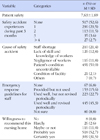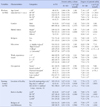Abstract
Purpose
The purpose of this study was to investigate provide basic data for improving patient safety in nursing homes in Korea by measuring the patient safety culture of nursing homes and understanding its influencing factors.
Methods
This study is a secondary analysis of a descriptive research study using data from development and validation of the Korean patient safety culture scale for nursing homes. A total of 982 cases were analyzed using the SPSS Statistics 20 program.
Results
For the safety culture of the patient, there was a significant difference based on the size and location of the facility. For the degree of patient safety, age, education, occupation, marital status, and the size of the nursing home were significant factors. Patient safety culture and the degree of patient safety had a positive correlation. The regression model of the degree of patient safety was significant (F=20.73, p<.001) and the explanatory power of the model was 27.4%.
Figures and Tables
References
1. Castle NG. Nurse aides' ratings of the resident safety culture in nursing homes. Int J Qual Health Care. 2006; 18(5):370–376. http://dx.doi.org/10.1093/intqhc/mzl038.
2. Bonner AF, Castle NG, Perera S, Handler SM. Patient safety culture: A review of the nursing home literature and recommendations for practice. Ann Longterm Care. 2008; 16(3):18–22.
3. Kim JS, Oh HY. Perceptions and attitude on use of physical restraints among caregivers in long term care facilities. J Korean Gerontol Soc. 2006; 26(2):347–360.
4. Castle NG, Ferguson JC. What is nursing home quality and how is it measured? Gerontologist. 2010; 50(4):426–442. http://dx.doi.org/10.1093/geront/gnq052.
5. Institute of Medicine (IOM), Committee on Quality of Health Care in America. Crossing the quality chasm: A new health system for the 21st century. Washington, DC: National Academy Press;2001.
6. Maas ML, Specht JP, Buckwalter KC, Gittler J, Bechen K. Nursing home staffing and training recommendations for promoting older adults' quality of care and life: Part 2. Increasing nurse staffing and training. Res Gerontol Nurs. 2008; 1(2):134–152. http://dx.doi.org/10.3928/19404921-20080401-04.
7. Gruneir A, Mor V. Nursing home safety: Current issues and barriers to improvement. Annu Rev Public Health. 2008; 29:369–382. http://dx.doi.org/10.1146/annurev.publhealth.29.020907.090912.
8. Kim MC, Cho H, Sunwoo S, Kim SW, Cho HJ. Prevalence and associated factors of fall among the elderly in nursing home. J Korean Geriatr Soc. 1999; 3(4):29–38.
9. Yoon SH, Kim B, Shin SY, Wu XL. Measuring patient safety culture in Korean nursing homes. J Korean Acad Nurs Adm. 2013; 19(2):315–327. http://dx.doi.org/10.11111/jkana.2013.19.2.315.
10. Yoon SH, Wu XL. Content analysis of patient safety culture in nursing homes. J Korean Acad Nurs Adm. 2013; 19(1):118–127. http://dx.doi.org/10.11111/jkana.2013.19.1.118.
11. Handler SM, Castle NG, Studenski SA, Perera S, Fridsma DB, Nace DA, et al. Patient safety culture assessment in the nursing home. Qual Saf Health Care. 2006; 15:400–404. http://dx.doi.org/10.1136/qshc.2006.018408.
12. Flin R, Yule S. Leadership for safety: Industrial experience. Qual Saf Health Care. 2004; 13:ii45–ii51. http://dx.doi.org/10.1136/qshc.2003.009555.
13. Castle NG, Sonon KE. A culture of patient safety in nursing homes. Qual Saf Health Care. 2006; 15(6):405–408. http://dx.doi.org/10.1136/qshc.2006.018424.
14. Seago JA, Williamson A, Atwood C. Longitudinal analyses of nurse staffing and patient outcomes: More about failure to rescue. J Nurs Adm. 2006; 36(1):13–21.
15. Hughes CM, Lapane KL. Nurses' and nursing assistant's perception's of patient safety culture in nursing homes. Int J Qual Health Care. 2006; 18:281–286.
16. Scott-Cawiezell J, Vogelsmeier A, McKenney C, Rantz M, Hicks L, Zellmer D. Moving from a culture of blame to a culture of safety in the nursing home setting. Nurs Forum. 2006; 41(3):133–140. http://dx.doi.org/10.1111/j.1744-6198.2006.00049.x.
17. Kim JE, Kang MA, An KE, Sung YH. A survey of nurses' perception of patient safety related to hospital culture and reports of medical errors. Clin Nurs Res. 2007; 13(3):169–179.
18. Yoon SH, Kim BS, Kim SY. Development and validation of the Korean patient safety culture for nursing homes. J Korean Acad Nurs. 2013; 43(3):379–388. http://dx.doi.org/10.4040/jkan.2013.43.3.379.
19. Agency for Healthcare Research and Quality (AHRQ). Nursing home surveys on patient safety culture [Internet]. Rockville, MD: AHRQ;2008. cited 2012 May 9. Available from: http://www.ahrq.gov/professionals/quality-patient-safety/patientsafetyculture/nursing-home/index.html.
20. Korean Statistical Information Service (KOSIS). Long term care insurance statistics [Internet]. Daejeon: Statistics Korea;2013. cited 2014 March 12. Available from: http://kosis.kr/statHtml/statHtml.do?orgId=350&tblId=DT_35006_N022&vw_cd=MT_ZTITLE&list_id=350_35006_A004&scrId=&seqNo=&lang_mode=ko&obj_var_id=&itm_id=&conn_path=E1.
21. Nicklin W, McVeety JE. Canadian nurses' perceptions of patient safety in hospitals. Can J Nurs Leadersh. 2002; 15(3):11–21.
22. Pronovost P, Weast B, Rosenstein B, Sexton JB, Holzmueller CG, Paine L, et al. Implementing and validating a comprehensive unit-based safety program. J Patient Saf. 2005; 1(1):33–40.
23. Blegen MA, Gearhart S, O'Brien R, Sehgal NL, Alldredge BK. AHRQ's hospital survey on patient safety culture: Psychometric analyses. J Patient Saf. 2009; 5(3):139–144. http://dx.doi.org/10.1097/PTS.0b013e3181b53f6e.
24. Stone P, Walker PH. Focus on patient safety. In : Fitzpatrick JJ, editor. Annual review of nursing research, v. 24. New York: Springer;2007.
25. Cooper MD, Phillips RA. Exploratory analysis of the safety climate and safety behavior relationship. J Safety Res. 2004; 35(5):497–512. http://dx.doi.org/10.1016/j.jsr.2004.08.004.
26. Gore DC, Powell JM, Baer JG, Sextone KH, Richardson CJ, Marshall DR, et al. Crew resource management improved perception of patient safety in the operating room. Am J Med Qual. 2010; 25(1):60–63. http://dx.doi.org/10.1177/1062860609351236.
27. McFadden KL, Henagan SC, Gowen CR. The patient safety chain: Transformational leadership's effect on patient safety culture, initiatives, and outcomes. J Oper Manag. 2009; 27(5):390–404. http://dx.doi.org/10.1016/j.jom.2009.01.001.
28. Nieva VF, Sorra J. Safety culture assessment: A tool for improving patient safety in healthcare organizations. Qual Saf Health Care. 2003; 12:Suppl 2. ii17–ii23. http://dx.doi.org/10.1136/qhc.12.suppl_2.ii17.




 PDF
PDF ePub
ePub Citation
Citation Print
Print







 XML Download
XML Download